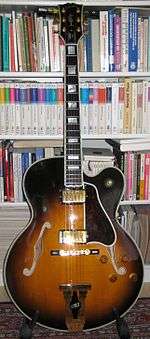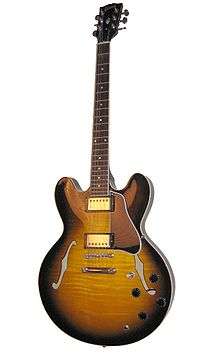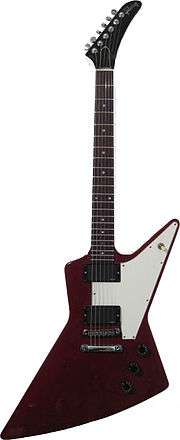Gibson
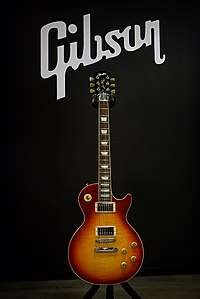 Gibson Logo and their signature Les Paul guitar shot at the Gibson Showroom | |
Formerly | Gibson Guitar Corp. |
|---|---|
| Private | |
| Industry | Musical instruments |
| Founded | 1902[1] in Kalamazoo, Michigan |
| Founder | Orville Gibson |
| Headquarters | Nashville, Tennessee, U.S. |
Area served | Worldwide |
Key people |
|
| Products |
Archtop, acoustic and electric guitars Bass guitars Mandolins Audio equipment |
| Subsidiaries |
List
|
| Website | gibson.com |
Coordinates: 36°07′48″N 86°43′33″W / 36.1298758°N 86.7257458°W
Gibson Brands, Inc. (formerly Gibson Guitar Corporation) is an American manufacturer of guitars, other musical instruments, and consumer and professional electronics from Kalamazoo, Michigan and now based in Nashville, Tennessee. The company was formerly known as Gibson Guitar Corporation and renamed Gibson Brands, Inc. on June 11, 2013.[3][4]
Gibson sells guitars under a variety of brand names[5] and builds one of the world's most iconic guitars, the Gibson Les Paul. Many Gibson instruments are highly collectible. Gibson was at the forefront of innovation in acoustic guitars, especially in the big band era of the 1930s; the Gibson Super 400 was widely imitated. In 1952, Gibson introduced its first solid-body electric guitar, the Les Paul, which became its most popular guitar to date— designed by Ted McCarty and Les Paul.
In addition to guitars, Gibson offers consumer electronics through its subsidiaries Gibson Innovations (Philips brand), TEAC Corporation (TEAC and Esoteric brands), Onkyo Corporation (Onkyo and Pioneer brands), Cerwin Vega and Stanton,[6] as well as professional audio equipment from KRK Systems, pianos from their wholly owned subsidiary Baldwin Piano, and music software from Cakewalk. (See section #Instruments)
Orville Gibson founded the company in 1902 as the "Gibson Mandolin-Guitar Mfg. Co. Ltd." in Kalamazoo, Michigan, to make mandolin-family instruments.[1] Gibson invented archtop guitars by constructing the same type of carved, arched tops used on violins. By the 1930s, the company was also making flattop acoustic guitars, as well as one of the first commercially available hollow-body electric guitars, used and popularized by Charlie Christian. In 1944, Gibson was bought by Chicago Musical Instruments (CMI), which was acquired in 1969 by Panama-based conglomerate Ecuadorian Company Limited (ECL), that changed its name in the same year to Norlin Corporation. Gibson was owned by Norlin Corporation from 1969 to 1986. In 1986, the company was acquired by its present owners. Gibson is a privately held company that is owned by its chief executive officer Henry Juszkiewicz and its president David H. Berryman.
On May 1, 2018, the company filed for Chapter 11 bankruptcy protection,[7] and announced a restructuring deal to return to profitability by closing down unprofitable consumer electronics divisions such as Gibson Innovations.[8][9] (See section #Bankruptcy)
History
Beginnings
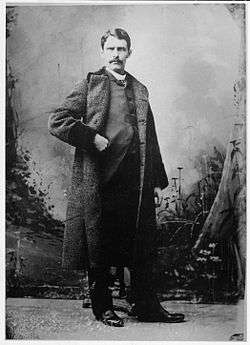


(c. 1912).
Orville Gibson patented a single-piece mandolin design in 1898 that was more durable than other mandolins and could be manufactured in volume.[10] Orville Gibson began to sell his instruments in 1894 out of a one-room workshop in Kalamazoo, Michigan. In 1902, the Gibson Mandolin-Guitar Mfg. Co. Ltd. was incorporated to market the instruments. Initially, the company produced only Orville Gibson's original designs.[11] Orville died in 1918 of endocarditis (inflammation of the inside lining of the heart chambers and valves).[10]
The following year, the company hired designer Lloyd Loar to create newer instruments.[11] Loar designed the flagship L-5 archtop guitar and the Gibson F-5 mandolin that was introduced in 1922, before leaving the company in 1924.[12] In 1936, Gibson introduced their first "Electric Spanish" model, the ES-150, followed by other electric instruments like steel guitars, banjos and mandolins.
During World War II, instrument manufacturing at Gibson slowed due to shortages of wood and metal, and Gibson began manufacturing wood and metal parts for the military. Between 1942-1945, Gibson employed women to manufacture guitars. "Women produced nearly 25,000 guitars during World War II yet Gibson denied ever building instruments over this period," according to a 2013 history of the company. Gibson folklore has also claimed its guitars were made by "seasoned craftsmen" who were "too old for war."[13][14]
In 1944 Gibson was purchased by Chicago Musical Instruments. The ES-175 was introduced in 1949. Gibson hired Ted McCarty in 1948, who became President in 1950. He led an expansion of the guitar line with new guitars such as the "Les Paul" guitar introduced in 1952 and designed by Les Paul, a popular musician in the 1950s and also a pioneer in music technology. The Les Paul was offered in Custom, Standard, Special, and Junior models.[15] In the mid-50s, the Thinline series was produced, which included a line of thinner guitars like the Byrdland. The first Byrdlands were slim, custom built, L-5 models for guitarists Billy Byrd and Hank Garland. Later, a shorter neck was added. Other models such as the ES-350T and the ES-225T were introduced as less costly alternatives.[16] In 1958, Gibson introduced the ES-335T model. Similar in size to the hollow-body Thinlines, the ES-335 family had a solid center, giving the string tone a longer sustain.
In the 1950s, Gibson also produced the Tune-o-matic bridge system and its version of the humbucking pickup, the PAF ("Patent Applied For"), first released in 1957 and still sought after for its sound. In 1958, Gibson produced two new designs: the eccentrically shaped Explorer and Flying V. These "modernistic" guitars did not sell initially. It was only in the late 1960s and early 70s when the two guitars were reintroduced to the market that they sold well. The Firebird, in the early 60s, was a reprise of the modernistic idea, though less extreme.
Modernization
In the late 50s, McCarty knew that Gibson was seen as a traditional company and began an effort to create more modern guitars. In 1961 the body design of the Les Paul was changed due to the demand for a double-cutaway body design.[17] The new body design then became known as the SG (for "solid guitar"), due to disapproval from Les Paul himself. The Les Paul returned to the Gibson catalog in 1968.
On December 22, 1969, the Gibson parent company Chicago Musical Instruments was taken over by the South American brewing conglomerate ECL. Gibson remained under the control of CMI until 1974 when it became a subsidiary of Norlin Musical Instruments. Norlin Musical Instruments was a member of Norlin Industries which was named for ECL president Norton Stevens and CMI president Arnold Berlin. This began an era characterized by corporate mismanagement and decreasing product quality.
.jpg)


Between 1974 and 1984, production of Gibson guitars was shifted from Kalamazoo to Nashville, Tennessee. The Kalamazoo plant kept going for a few years as a custom-instrument shop, but was closed in 1984; several Gibson employees led by plant manager Jim Duerloo established Heritage Guitars in the old factory, building versions of classic Gibson designs.
The company was within three months of going out of business before it was bought by Henry E. Juszkiewicz, David H. Berryman, and Gary A. Zebrowski in January 1986.[18] Gibson's wholesale shipments in 1993 were an estimated $70 million, up from $50 million in 1992. When Juszkiewicz and Berryman took over in 1986, sales were below $10 million.[19] New production plants were opened in Memphis, Tennessee, as well as Bozeman, Montana. The Memphis facility is used for semi-hollow and custom shop instruments, while the Bozeman facility is dedicated to acoustic instruments.[20]
In 1977, Gibson sued Hoshino Gakki/Elger Guitars for copying the Les Paul.[21] In 2000, Gibson sued Fernandes Guitars in a Tokyo court for allegedly copying Gibson designs. Gibson did not prevail.[22] Gibson also sued PRS Guitars in 2005, to stop them from making their Singlecut model. The lawsuit against PRS was initially successful.[23] However, the United States Court of Appeals for the Sixth Circuit reversed the lower court decision and ordered the dismissal of Gibson's suit against PRS.[24]
Recent history
Gibson purchased Garrison Guitars in 2007.[25] In mid 2009 Gibson reduced its work force to adjust for a decline in guitar industry sales in the United States.[26]
Gibson filed a lawsuit November 18, 2010 in Federal court, the Central District of California, against WowWee USA and their Paper Jamz battery operated guitar toys charging trademark infringement.[27][28] The lawsuit claimed the Paper Jamz toy guitars copied the looks of some of Gibson’s famous guitars, the Gibson Les Paul, the Gibson Flying V, the Gibson Explorer, and the Gibson SG. On December 21, 2010 Gibson was granted a request for an injunction against WowWee and retailers in the United States which were selling Paper Jamz guitars: WalMart, Amazon (company), Big Lots stores, Kmart Corporation, Target Corporation, Toys “R” Us, Walgreens, Brookstone, Best Buy, eBay, Toywiz.com, and Home Shopping Network (HSN)[29][30][31] The case was dismissed with prejudice (dismissed permanently) January 11, 2011 by Federal Judge R. Gary Klausner.[32][33]
In 2011, Gibson acquired the Stanton Group, including Cerwin Vega, KRK Systems and Stanton DJ. Gibson then formed a new division, Gibson Pro Audio, which will deliver professional grade audio items, including headphones, loudspeakers and DJ equipment.[34]
Gibson announced a partnership with the Japanese-based Onkyo Corporation in 2012. Onkyo, known for audio equipment and home theater systems, became part of the Gibson Pro Audio division.[35]
In 2013, Gibson acquired a majority stake in TEAC Corporation.
In 2014, Gibson acquired the consumer electronics business of Royal Philips.
In October 2017, Gibson announced plans to relocate its Memphis operations to a smaller location and plans to sell the Memphis property. Gibson opened its Memphis facility 18 years before, which occupies just a portion of a massive 127,620 square foot complex. According to the Memphis Daily News, Gibson plans to search for a new facility for its Memphis operations and will stay in the current spot for the next 18 to 24 months. The facility, which sits across from the FedExForum along South B.B. King Boulevard, is expected to list for $17 million.
Since its opening, the Gibson Memphis shop has mostly focused on building hollow and semi-hollowbody guitars, such as the famed ES series. Presumably, this shuffling of assets is meant to address Gibson's well-publicized financial troubles.
Gibson issued a press release about the move, with CEO Henry Juszkiewicz stating:
"We are extremely excited about this next phase of growth that we believe will benefit both our employees, and the Memphis community. I remember when our property had abandoned buildings, and Beale Street was in decline. It is with great pride that I can see the development of this area with a basketball arena, hotels, and a resurgent pride in the musical heritage of the great city of Memphis. We continue to love the Memphis community and hope to be a key contributor to its future when we move nearby to a more appropriate location for our manufacturing based business, allowing the world the benefit of our great American craftsmen."[36]
FWS raids & Lacey Act violation
Gibson's factories were raided in 2009 and 2011 by agents of the United States Fish and Wildlife Service (FWS). In November 2009 authorities found illegally imported ebony wood from Madagascar.[37][38] A second raid was conducted in August 2011,[37] during which the FWS seized wood imports from India that had been mislabeled on the US Customs declaration.[39][40] Gibson Guitar Corp. filed a motion in January 2011 to recover seized materials and overturn the charges, which was denied by the court.[41][42]
The United States Department of Justice found emails from 2008 and 2009 in which Gibson employees discussed the "gray market" nature of the ebony wood available from a German wood dealer—who obtained it from a supplier in Madagascar—as well as plans to obtain the wood. It filed a civil proceeding in June 2011,[40][43][44] the first such case under the amended Lacey Act, which requires importing companies to purchase legally harvested wood and follow the environmental laws of the producing countries regardless of corruption or lack of enforcement.[44] Gibson argued in a statement the following day that authorities were "bullying Gibson without filing charges" and denied any wrongdoing.[39][45] Arguing against the federal regulations and claiming that the move threatened jobs, Republicans and Tea Party members spoke out against the raids and supported Juszkiewicz.[46]
The case was settled on August 6, 2012, with Gibson admitting to violating the Lacey Act and agreeing to pay a fine of $300,000 in addition to a $50,000 community payment. Gibson also forfeited the wood seized in the raids, which was valued at roughly the same amount as the settlement.[47][48] However, in a subsequent statement Gibson maintained its innocence with Juszkiewicz claiming that "Gibson was inappropriately targeted" and that the government raids were "so outrageous and overreaching as to deserve further Congressional investigation." Juszkiewicz continued to state, "We felt compelled to settle as the costs of proving our case at trial would have cost millions of dollars and taken a very long time to resolve."[49]
The case raised concerns for musicians who lack documentation of vintage instruments made of traditional, non-sustainable materials.[50][51] However, officials from the Justice Department and the U.S. Fish and Wildlife Service have stated that musicians who unknowingly possess instruments made from illegal wood would not be treated as criminals.[52]
Gibson was able to reclaim some wood stock which was confiscated during the raids,[53] and produced a new series of guitar marketed to draw attention to the raids and seizures.[54]
In the midst of the controversy, conservative commentators alleged that the raid was a politically motivated act of retaliation by the Obama administration, as Juszkiewicz had frequently donated to Republican politicians, including Marsha Blackburn and Lamar Alexander. Chris Martin IV, the CEO of Gibson competitor C.F. Martin & Co., had donated over $35,000 to the Democratic National Committee and Democratic candidates in the same time period. Though Martin featured several guitars in its catalog made with the same Indian wood as Gibson, the company was not subjected to a raid.[55] Following revelations in the 2013 IRS targeting controversy, the right-leaning magazine FrontPage declared that "there is now little doubt the raid...was politically motivated," and that "the Gibson Guitar case can hardly be dismissed as regulatory overreach. In hindsight, it was an ominous foreshadowing of the explosion of misdeeds we are witnessing today.[56]
Bankruptcy
On May 1, 2018, the company filed for Chapter 11 bankruptcy protection. As part of its debt restructuring, the company will close down and liquidate its unprofitable Gibson Innovations division, which sells audio equipment outside of the U.S. and has been the source of much of the company's financial troubles. The restructuring will allow Gibson to focus on its most profitable ventures, such as musical instruments. No changes will be made to its guitar manufacturing business, and all Gibson and Epiphone branded guitars are expected to continue in production uninterrupted. Additionally, $135 million was provided by existing creditors to provide liquidity to maintain existing operations.[57][58]
On September 6, 2018, the company announced that a global settlement has been reached with respect to the company’s reorganization plan upon emergence from Chapter 11. Under the plan, the company will be focused on its core musical instruments business with "essentially no debt." Current Chairman and CEO Henry Juszkiewicz will step down as CEO and assume the role of consultant. With immediate effect, Brian J. Fox, the company’s CRO, will oversee daily operations until a new CEO is appointed.[59]
Instruments
Gibson also owns and makes instruments under brands such as Epiphone,[60] Kramer,[61] Maestro,[62] Steinberger,[63] and Tobias,[64]—along with the ownership of historical brands such as Kalamazoo,[65][66] Dobro,[5] Slingerland,[67] Valley Arts,[67] and Baldwin[5] (including: Chickering,[67] Hamilton,[67] Wurlitzer[5][67]).
Although it is well known for its guitars, Gibson's largest business is in fact electronics. Gibson offers consumer audio equipment devices through its subsidiaries Gibson Innovations (Philips brand), Onkyo Corporation (Onkyo and Pioneer brands), TEAC Corporation (Teac and Esoteric brands), Cerwin Vega and Stanton,[6] as well as professional audio equipment from KRK Systems and TEAC Corporation/TASCAM.
Gibson makes authorized copies of its most successful guitar designs. They are less expensive than those bearing the Gibson name. A former competitor, Epiphone was purchased by Gibson and now makes competitively priced Gibson models, such as the Les Paul and SG, sold under the Epiphone brand,[68] while continuing to make Epiphone-specific models like the Sheraton, Sorrento, and Casino. In Japan, Orville by Gibson once made Gibson designs sold in that country.[69] Gibson has sought legal action against those that make and sell guitars Gibson believes are too similar to their own.
In 1977, Gibson introduced the serial numbering system in use until 2006.[70] An eight-digit number on the back shows the date when the instrument was produced, where it was produced, and its order of production that day (e.g., first instrument stamped that day, second, etc.).[71] As of 2006, the company used seven serial number systems,[70] making it difficult to identify guitars by their serial number alone.[70][71] and as of 1999 the company has used six distinct serial numbering systems.[71] An exception is the year 1994, Gibson's centennial year; many 1994 serial numbers start with "94", followed by a six-digit production number. The Gibson website provides a book to help with serial number deciphering.[71]
In 2006, Gibson introduced a nine-digit serial number system replacing the eight-digit system used since 1977, but the sixth digit now represents a batch number.[70]
In 2003,[72] Gibson debuted its Ethernet-based[73] audio protocol, MaGIC, which it developed in partnership with 3COM, Advanced Micro Devices, and Xilinx.[72] Replacing traditional analog hook-ups with a digital connection that would, "...satisfy the unique requirements of live audio performances," may have been the goal of this project.[73] This system may require a special pickup,[72] but cabling is provided by a standard Cat-5 ethernet cable.[72][73]
The Gibson "self-tuning guitar", also known as a "robot model", an option on some newer Les Paul, SG, Flying V and Explorer instruments, will tune itself in little more than two seconds using robotics technology developed by Tronical GmbH.[74] Under the tradename Min-ETune, this device became standard on several models in 2014.[75]
In 2013, Gibson introduced the Government Series of Les Paul, SG, Flying V, Explorer and ES-335 guitars which were constructed solely of tonewood the US government seized but later returned to Gibson after the resolution of the company's Lacey Act violation in 2011. The guitars were finished in "government grey" and also featured decorations which intended to draw attention to the issue of government. A year later in 2014, Gibson released the Government Series II[76] of guitars, which were essentially the same as the first series, only finished in a new color: "government tan".
Factories
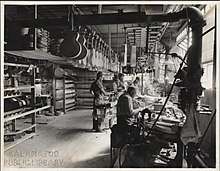
All Gibson-brand guitars are currently made at three facilities, depending on the type of guitar. Solid body electric guitars such as the Gibson Les Paul and the Gibson SG are made in Nashville, Tennessee. Semi-acoustic guitars such as the Gibson ES Series are made in Memphis, Tennessee. Full acoustic guitars such as the Gibson J Series are made in Bozeman, Montana. The Nashville and Bozeman facilities are off-limits to visitors, but the Memphis facility gives regularly scheduled factory tours.
All Gibson instruments are made in USA. Below are some of the facilities used to produce Gibson instruments, along with years of their operation:
| Address | Years of Operation | Notes |
|---|---|---|
| 114 So. Burdick, Kalamazoo, MI. | 1896–1897 | This was the "business location" of "O. H. Gibson, Manufacturer, Musical Instruments."[77] |
| 104 East Main, Kalamazoo, MI | 1899–1902 | This was Orville Gibson’s residence, and he built instruments on the 2nd floor of this location.[77][78] |
| 114 East Main, Kalamazoo, MI | 1902–1906 | The "Gibson Mandolin-Guitar Manufacturing Co, Ltd." was established in 1902.[77] This building, said to be infested with cockroaches, was probably the former Witmer Bakery.[79] |
| 114 East Exchange Place, Kalamazoo, MI | 1906–1911 | Located quite close to the previous location, in Kalamazoo’s business district.[80] |
| 521–523 East Harrison Court, Kalamazoo, MI | 1911–1917 | Located about .5 miles from previous location. The building was next to the Michigan Central Railroad, and stood for many decades, until it came down in the late 20th century.[81] |
| 225 Parsons St, Kalamazoo, MI, 49007 | 1917–1984 | Also located next to railroad tracks, this facility had major expansions in 1945, 1950, and 1960.[82] Various brands were produced there, including Gibson, Epiphone, (1957–1970)[83][84] and Kalamazoo. During the depression of the 1930s, children's toys were produced there, and during WW2 it produced materials to support the war effort in addition to producing guitars.[85] Between 1974 and 1984 Gibson moved its manufacturing out of this facility to Tennessee. Most of this move happened in 1974, leaving only acoustic and some semi-acoustic production for this plant.[86] In 1985, Heritage Guitars began production, renting part of this facility.[87] |
| 641 Massman Drive, Nashville, TN, 37210 | 1984–present | This is Gibson's facility for production of their main solid body models, such as the Les Paul and the SG. |
| 145 Lt. George W. Lee Av, Memphis, TN 38103 | 2000–present | This is Gibson's facility for production of their semi-hollowbody electric guitars. This facility shares the same building as Gibson's Retail Shop and Beale Street "Showcase" location.[88] |
| 1894 Orville Way, Bozeman, MT, 59715 | 1989[89]– present | This facility is dedicated to acoustic guitar production. |
See also
- David Harvey (luthier)
- Jim Triggs (luthier)
- Lloyd Loar (luthier)
- List of Gibson players
Footnotes
- 1 2 "Gibson History". Gibson Corporate Press Kit. Gibson Guitar Corp. Archived from the original on 29 April 2012. Retrieved 20 May 2012.
- ↑ Gisbon Brands at Gibson Press website Archived 2014-07-05 at the Wayback Machine., retrieved 10 Dec 2014
- ↑ "Gibson Brands, Inc.: Private Company Information". Bloomberg. Archived from the original on 2017-06-25.
- ↑ "Drop the guitar Gibson rebrands" on BizJournals.com Archived 2014-12-25 at the Wayback Machine.
- 1 2 3 4 Ayala Ben-Yehuda (9 April 2007). "Gibson Guitar embraces China, Latin markets". Reuters. Archived from the original on 2015-09-24.
- 1 2 Gibson Pro Audio line Archived 2014-12-07 at the Wayback Machine., 10 Dec 2014
- ↑ "Gibson Guitars Files For Bankruptcy Protection". NPR.org. Retrieved 2018-05-03.
- ↑ "US guitar firm Gibson goes bust". BBC News. 2018-05-02. Retrieved 2018-05-03.
- ↑ Mattise, Jonathan (2018-05-02). "Gibson guitar maker sees a future with bankruptcy protection". CTVNews. Retrieved 2018-05-03.
- 1 2 "Orville H. Gibson, 1856—1918". Siminoff.net. Archived from the original on 2011-02-25. Retrieved 2011-01-28.
- 1 2 "Gibson Dusk Tiger". Gibson.com. 2008-06-24. Archived from the original on 2011-01-20. Retrieved 2011-01-28.
- ↑ Wheeler, Tom. American Guitars. HarperCollins. 1992.pp 100—1 ISBN 978-0-06-273154-8
- ↑ Lister, Kat (2014-04-23). "The Forgotten Women of Kalamazoo". Feminist Times. Archived from the original on 2014-06-27. Retrieved 2014-09-15.
- ↑ Thomas, John (2012). Kalamazoo gals: a story of extraordinary women and Gibson's banner guitars of WWll. Franklin, TN: American History Press. ISBN 9780983082781.
- ↑ Hembree 2007, p. 74—85
- ↑ Duchossoir 1998, p. 55—62
- ↑ Hembree 2007, p. 110
- ↑ Hembree 2007, p. 306
- ↑ Miller, Bryan. "Saving Gibson Guitars From the Musical Scrap Heap". The New York Times. Retrieved 8 October 2018.
- ↑ Gleick 1987
- ↑ Fjestad, Zachary (June 16, 2010). "Ibanez "Lawsuit Era" Les Paul Custom Copy". Premier Guitar. Archived from the original on November 3, 2013.
- ↑ "Northwestern Journal of Technology and Intellectual Property | Vol 4 | Iss 2" (PDF). Law.northwestern.edu. 2010-08-19. Archived (PDF) from the original on 2011-08-14. Retrieved 2012-05-09.
- ↑ Gibson Guitar Corp. v. Paul Reed Smith Guitars, L.P. Archived 2014-01-15 at the Wayback Machine., 325 F. Supp. 2d 841 (M.D. Tenn., 2004)
- ↑ Gibson Guitar Corp. v. Paul Reed Smith Guitars, LP Archived 2014-11-10 at the Wayback Machine., 423 F.3d 539 (6th Cir. 2005).
- ↑ Garrison Guitars sold to Gibson Archived 2012-04-07 at the Wayback Machine. thetelegram.com, July 4th, 2007
- ↑ Email, published by Walker Duncan (2009-03-23). "Sources: Gibson adds to layoff tally | Make and Buy | NashvillePost.com: Nashville Business News + Nashville Political News". NashvillePost.com. Archived from the original on 2011-10-01. Retrieved 2011-01-28.
- ↑ "Gibson Sues Over Paper Jamz". Guitar News Daily, November 25, 2010. Archived from the original on February 2, 2018. Retrieved February 1, 2018.
- ↑ Hachman, Mark. "Gibson Sues WowWee over Paper Jamz Guitars". PC Magazine, November 27, 2010. Archived from the original on February 3, 2018. Retrieved February 2, 2018.
- ↑ "Gibson Granted Injunction Against Paper Jamz Guitars". Premier Guitar, December 22, 2010. Archived from the original on April 27, 2018. Retrieved February 2, 2018.
- ↑ Hasselback, Drew. "Gibson obtains injunction against WowWee's Paper Jamz guitars". Financial Post, December 23, 2010. Archived from the original on February 3, 2018. Retrieved February 2, 2018.
- ↑ Biggs, John. "Gibson Forces WowWee to Pull Paper Jamz Guitars". TechCrunch, December 28, 2010. Archived from the original on February 3, 2018. Retrieved February 2, 2018.
- ↑ Gibson Guitar Corp. v. WowWee USA, Inc. et al (Central District of California 2011) ("That this action is dismissed with prejudice without costs or attorneys fees; That the funds deposited by plaintiff to secure the preliminary injunction be returned to plaintiff."). Text
- ↑ Roberts, Katie. "Wowwee/Gibson Guitars dispute settled". ToyNews, January 7, 2011. Archived from the original on February 3, 2018. Retrieved February 2, 2018.
- ↑ "Gibson Guitar increases high-tech lineup with purchase". Tennessean.com. 2011-12-06. Retrieved 2011-12-06.
- ↑ "Gibson Expands Pro Audio Division". Gibson.com. 2012-01-04. Archived from the original on 2012-02-09. Retrieved 2012-02-09.
- ↑ "Gibson Set to Sell Memphis Guitar Factory - Reverb News". Web.archive.org. 7 November 2017. Retrieved 8 October 2018.
- 1 2 Wadhwani, A.; Paine, A. (25 August 2011). "Gibson Guitar raided but lips zipped". The Tennessean. Archived from the original on 26 August 2011. Retrieved 26 August 2011.
- ↑ Lind, J.R. (29 December 2010). "Federal agent: Gibson wood investigation likely to result in indictments". NashvillePost.com. Archived from the original on 10 July 2011.
- 1 2 "Gibson Guitar Corp. responds to federal raid". Gibson Guitar Corp. 25 August 2011. Archived from the original on 12 September 2011. Retrieved 1 September 2011.
- 1 2 Trotter, J. (25 August 2011). "Endangered lemurs could be connected to Gibson raid". WMCTV.com. Archived from the original on 26 August 2011. Retrieved 26 August 2011.
- ↑ "Update: CEO's Outrage Gets Media Buzzing". Gibson Guitar Corp. 26 August 2011. Archived from the original on 13 September 2011. Retrieved 1 September 2011.
- ↑ "Gibson Guitars fails to squash illegal wood investigation". Sound & Fair. 19 January 2011. Archived from the original on 2 April 2011. Retrieved 1 September 2011.
- ↑ "Gibson/Lacey Act Update". Home Furnishings Business. 6 July 2011. Archived from the original on 10 July 2011.
- 1 2 "Endangered species trafficking: What did Gibson Guitar know?". Mongabay.com. 7 July 2011. Archived from the original on 23 August 2011. Retrieved 23 August 2011.
- ↑ Stern, Andrew (25 August 2011). "Gibson Guitar to fight U.S. probe of its wood imports". Reuters. Archived from the original on 8 January 2012. Retrieved 1 September 2011.
- ↑ Schelzig, E. (August 7, 2012). "Gibson Guitar Corporation admits to importing endangered wood". The Christian Science Monitor. Archived from the original on 24 November 2014. Retrieved November 24, 2014.
- ↑ Black, R. (6 August 2012). "Gibson settles discord on timber". BBC News. Archived from the original on 7 August 2012. Retrieved 6 August 2012.
- ↑ Clarke, C.; Grant, A. (4 May 2011). "Are your wood products really certified?". Wri.org. Archived from the original on 23 August 2011. Retrieved 23 August 2011.
- ↑ "Gibson Comments on Department of Justice Settlement". Gibson Guitar Corporation. August 6, 2012. Archived from the original on 24 November 2014. Retrieved November 24, 2014.
- ↑ Felten, E. (26 August 2011). "Guitar frets: Environmental enforcement leaves musicians in fear". The Wall Street Journal. Archived from the original on 9 March 2015. Retrieved 1 September 2011.
- ↑ Simmons, L. (31 August 2011). "Raid highlights music manufacturers' environmental risks". bizmology.com. Archived from the original on 29 September 2011. Retrieved 1 September 2011.
- ↑ Eilperin, J. (13 November 2011). "Gibson Guitar ignites debate over environmental protections". Washington Post. Archived from the original on 16 November 2011. Retrieved 16 November 2011.
- ↑ "Gibson launches 'Government Series' guitars with tonewood seized in 2011 raid". The Washington Times. Archived from the original on 28 June 2017. Retrieved 27 April 2018.
- ↑ Faughnder, Ryan (15 February 2014). "Gibson guitars made with government-seized wood are sold out". Los Angeles Times. Archived from the original on 21 August 2015.
- ↑ "Now the Gibson Guitar Raids Make Sense". www.investors.com. Investors' Business Daily. May 23, 2013. Retrieved July 14, 2018.
According to C.F. Martin's catalog, several of their guitars contain 'East Indian Rosewood,' which is the exact same wood in at least 10 of Gibson's guitars. So why were they not raided and their inventory of foreign wood seized? Grossly underreported at the time was the fact that Gibson's chief executive, Henry Juszkiewicz, contributed to Republican politicians...By contrast, Chris Martin IV, the Martin & Co. CEO, is a long-time Democratic supporter.
- ↑ "Gibson Guitar and the Politics of Persecution". Frontpagemag.com. May 28, 2013. Retrieved July 14, 2018.
- ↑ Snyder, Eric (1 May 2018). "Gibson files for Chapter 11 brankruptcy". Nashville Business Journal. Retrieved 2 May 2018.
- ↑ "Gibson files for bankruptcy in a deal to renew its guitar business". Bloomburg. Retrieved 2 May 2018.
- ↑ "Gibson Brands reaches global settlement and files amended plan of reorganization". PR Newswire. 6 September 2018. Retrieved 25 September 2018.
- ↑ "epiphone.com". Epiphone.com. Archived from the original on 2012-05-09. Retrieved 2012-05-09.
- ↑ kramerguitars.com Archived 2008-12-18 at the Wayback Machine. Kramer Official Site
- ↑ Maestro by Gibson Archived 2010-07-19 at the Wayback Machine. Gibson Official Site
- ↑ steinberger.com Archived 2011-02-07 at the Wayback Machine. Steinberger Official Site
- ↑ Tobias Archived 2011-02-02 at the Wayback Machine. Gibson Official Site
- ↑ Ken Achard (1996). The History and Development of the American Guitar. Bold Strummer. p. 10. ISBN 978-0-933224-18-6.
Also during the mid to late thirties, Gibson produced a range of cello and flat top instruments under the Kalamazoo name and at inexpensive prices.
- ↑ "Gibson Kalamazoo". January 2, 2009. Archived from the original on November 30, 2011.
- 1 2 3 4 5 "Gibson Brands Announces Intention to Acquire Cakewalk Inc". Gibson Guitar Corporation. 23 September 2013. Archived from the original on 2015-05-18. Retrieved 10 May 2015.
- ↑ "Epiphone Les Paul Standard". Epiphone.com. Archived from the original on 2012-02-18.
- ↑ "Epiphone: A History — Epiphone and Gibson". Epiphone.com. Archived from the original on 2015-11-04.
- 1 2 3 4 Gibson Serial Numbers: What a serial number can and can't tell you about your Gibson Archived 2011-02-02 at the Wayback Machine. Gibson Official Site, 7.17.2007
- 1 2 3 4 Blue Book of Electric Guitars. Sixth Edition: Gibson Serialization. Edited by S.P. Fjestad Archived 2015-02-07 at the Wayback Machine. Gibson Official Site
- 1 2 3 4 The MaGIC of Gibson's Digital Guitars Maximum PC magazine, April 2003
- 1 2 3 This Is MaGIC Archived 2010-01-16 at the Wayback Machine. Gibson Official Site
- ↑ Yuri Kageyama (The Associated Press) (December 3, 2007). "World's first robot guitar takes care of the tuning". Seattle Times. Archived from the original on December 5, 2007. Retrieved 2007-12-04.
- ↑ "Archived copy". Archived from the original on 2014-11-29. Retrieved 2014-11-24.
- ↑ "Gibson Guitars Announces Government Series II Les Paul". guitarworld.com. Archived from the original on 26 September 2015. Retrieved 27 April 2018.
- 1 2 3 Wheeler 1992, p. 95
- ↑ Carter 1994, p. 12
- ↑ Spann 2011, p. 1
- ↑ Spann 2011, pp. 1–2
- ↑ Spann 2011, p. 2
- ↑ Wheeler 1992, pp. 101, 151
- ↑ Wheeler 1992, p. 144
- ↑ Bonds 2004, p. 318
- ↑ Thomas 2012, p. 3
- ↑ Bonds 2004, p. 396
- ↑ Bonds 2004, p. 406
- ↑ "Gibson Guitar Memphis Factory Tour Directions" (PDF). Archived (PDF) from the original on August 21, 2013. Retrieved March 24, 2014.
- ↑ Fjestad, S.P., Editor (2015) [1999]. "Blue Book of Electric Guitars" (PDF). Gibson Serialization (Sixth ed.). Blue Book Publications, Inc. Archived (PDF) from the original on February 7, 2015. Retrieved January 2, 2015.
References
- Achard, Ken (1989). The History and Development of the American Guitar. Westport, CT: Bold Strummer Ltd. ISBN 978-0-933-22418-6.
- Bacon, Tony (2002). 50 Years of the Gibson Les Paul. San Francisco: Backbeat Books. ISBN 978-0-879-30711-0.
- Bacon, Tony (2009). The Les Paul Guitar Book: A Complete History of Gibson Les Paul Guitars. San Francisco: Backbeat Books. ISBN 978-0-879-30951-0.
- Bacon, Tony (2011). Flying V, Explorer, Firebird: An Odd-shaped History of Gibson’s Weird Electric Guitars. Milwaukee, WI: Backbeat Books. ISBN 978-1-617-13008-3.
- Bacon, Tony (2012). The History of the American Guitar: From 1833 to the Present Day. San Francisco: Backbeat Books. ISBN 978-1-617-13033-5.
- Bacon, Tony (2014). Sunburst: How the Gibson Les Paul Standard Became a Legendary Guitar. Montclair: Backbeat Books. ISBN 978-1-617-13466-1.
- Bonds, Ray (2004). The Illustrated Directory of Gutiars. New York: Barnes and Noble. ISBN 978-0-760-76317-9.
- Carter, Walter (1994). Gibson Guitars: 100 Years of an American Icon. Los Angeles: General Publishing Group. ISBN 978-1-881-64939-7.
- Carter, Walter (2007). Gibson Electric Guitar Book – Seventy Years of Classic Guitars. Backbeat Books: New York. ISBN 978-0-879-30895-7.
- Day, Paul; Carter, Walter; Hunter, Dave; Verheyen, Carl (2011). The Ultimate Gibson Guitar Book. New York: Metro Books. ISBN 978-1-435-13756-1.
- Duchossoir, A. R. (1998). Gibson Electrics: The Classic Years. Milwaukee, WI: Hal Leonard. ISBN 978-0-793-59210-4.
- Duchossoir, A. R. (2008). Guitar Identification: A Reference for Dating Guitars made by Fender, Gibson, Gretsch, and Martin (4th ed.). Milwaukee, WI: Hal Leonard. ISBN 978-1-423-42611-0.
- Duchossoir, A. R. (2009). Gibson Electric Steel Guitars: 1935-1967. Milwaukee, WI: Hal Leonard. ISBN 978-1-423-45702-2.
- Erlewine, Dan; Whitford, Eldon; Vinopal, David (2009). Gibson’s Fabulous Flat-top Guitars: An Illustrated History & Guide. San Francisco: Backbeat Books. ISBN 978-0-879-30962-6.
- Fjestad, Zachary R.; Meiners, Larry (2007). Gibson Flying V. Minneapolis, MN: Blue Book Publications. ISBN 978-1-886-76872-7.
- Fox, Paul (2011). The Other Brands of Gibson. Anaheim Hills, CA: Centerstream Publications. ISBN 978-1-574-24271-3.
- Gleick, James (1987). Chaos: Making a New Science. New York: Viking. ISBN 978-0-670-81178-6.
- Gruhn, George; Carter, Walter (1993). Acoustic Guitars and Other Fretted Instruments: A Photographic History. San Francisco: GPI Books. ISBN 978-0-879-30240-5.
- Gruhn, George; Carter, Walter (2010a). Electric Guitars and Basses: A Photographic History. New York: Backbeat Books. ISBN 978-0-879-30974-9.
- Gruhn, George; Carter, Walter (2010b). Gruhn’s Guide to Vintage Guitars: An Identification Guide for American Fretted Instruments. New York: Backbeat Books. ISBN 978-0-879-30422-5.
- Hembree, George (2007). Gibson Guitars: Ted McCarty’s Golden Era 1948-1966. Austin, TX: GH Books. ISBN 978-1-423-41813-9.
- Ingram, Adrian (1997). The Gibson L5: Its History and its Players. Anaheim, CA: Centerstream Pub. ISBN 978-1-574-24047-4.
- Ingram, Adrian (2007). The Gibson 175: Its History and its Players. Anaheim, CA: Centerstream Pub. ISBN 978-1-574-24223-2.
- Marx, Wallace (2009). Gibson Amplifiers 1933-2008. Minneapolis, MN: Blue Book Publications. ISBN 978-1-886-76890-1.
- Spann, Joe (2011). Spann’s Guide to Gibson: 1902-1941. Anaheim Hills, CA: Centerstream Pub. ISBN 978-1-574-24267-6.
- Thomas, John (2012). Kalamazoo Gals: A Story of Extraordinary Women & Gibson’s ‘Banner’ Guitars of WWII. Franklin, TN: American History Press. ISBN 978-0-983-08278-1.
- Wheeler, Tom (1992). American Guitars: An Illustrated History (rev. and updated ed.). New York: HarperPerennial. ISBN 978-0-062-73154-8.
Further reading
- Fox, Paul (2011). The Other Brands of Gibson. Centerstream Publishing. ISBN 978-1-57424-271-3.
External links
| Wikimedia Commons has media related to Gibson. |
%2C_Virzi_(SN10002)_(2010-09-18_00.27.59_by_Joseph_Brent)_clip1.jpg)
%2C_Maybelle_Carter%2C_CMHF_clip1.jpg)
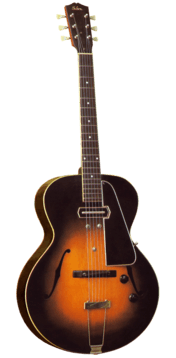
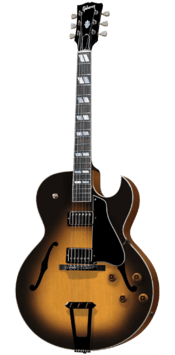
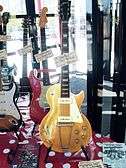


.png)
